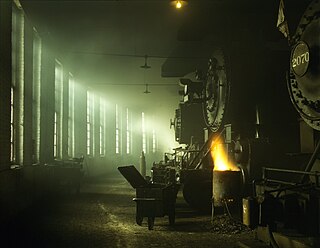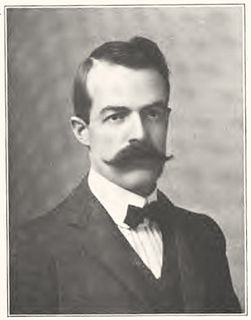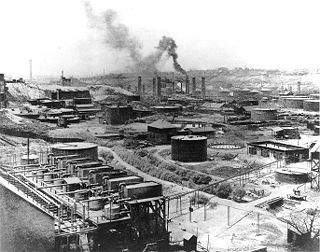Related Research Articles

The Interstate Commerce Commission (ICC) was a regulatory agency in the United States created by the Interstate Commerce Act of 1887. The agency's original purpose was to regulate railroads to ensure fair rates, to eliminate rate discrimination, and to regulate other aspects of common carriers, including interstate bus lines and telephone companies. Congress expanded ICC authority to regulate other modes of commerce beginning in 1906. Throughout the 20th century several of ICC's authorities were transferred to other federal agencies. The ICC was abolished in 1995, and its remaining functions were transferred to the Surface Transportation Board.
The Elkins Act is a 1903 United States federal law that amended the Interstate Commerce Act of 1887. The Act authorized the Interstate Commerce Commission (ICC) to impose heavy fines on railroads that offered rebates, and upon the shippers that accepted these rebates. The railroad companies were not permitted to offer rebates. Railroad corporations, their officers, and their employees, were all made liable for discriminatory practices.

The Hepburn Act is a 1906 United States federal law that gave the Interstate Commerce Commission (ICC) the power to set maximum railroad rates and extended its jurisdiction. This led to the discontinuation of free passes to loyal shippers. In addition, the ICC could view the railroads' financial records, a task simplified by standardized bookkeeping systems. For any railroad that resisted, the ICC's conditions would remain in effect until the outcome of legislation said otherwise. By the Hepburn Act, the ICC's authority was extended to cover bridges, terminals, ferries, railroad sleeping cars, express companies and oil pipelines.
The Mann–Elkins Act, also called the Railway Rate Act of 1910, was a United States federal law that strengthened the authority of the Interstate Commerce Commission (ICC) over railroad rates. The law also expanded the ICC's jurisdiction to include regulation of telephone, telegraph and wireless companies, and created a commerce court.
The Transportation Act, 1920, commonly known as the Esch–Cummins Act, was a United States federal law that returned railroads to private operation after World War I, with much regulation. It also officially encouraged private consolidation of railroads and mandated that the Interstate Commerce Commission (ICC) ensure their profitability.

The Staggers Rail Act of 1980 is a United States federal law that deregulated the American railroad industry to a significant extent, and it replaced the regulatory structure that had existed since the Interstate Commerce Act of 1887.

The Timeline of U.S.A Railway History depends upon the definition of a railway, as follows: A means of conveyance of passengers and goods on wheeled vehicles running on rails, also known as tracks.

Wooden railroads, called wagonways, were built in the United States starting from the 1720s. A railroad was reportedly used in the construction of the French fortress at Louisburg, Nova Scotia, in New France in 1720. Between 1762 and 1764, at the close of the French and Indian War (1756–1763), a gravity railroad is built by British military engineers up the steep riverside terrain near the Niagara River waterfall's escarpment at the Niagara Portage in Lewiston, New York.
The United States Railroad Administration (USRA) was the name of the nationalized railroad system of the United States between December 28, 1917, and March 1st, 1920. It was possibly the largest American experiment with nationalization, and was undertaken against a background of war emergency.

Conrail, formally the Consolidated Rail Corporation, was the primary Class I railroad in the Northeastern United States between 1976 and 1999. The trade name Conrail is a portmanteau based on the company's legal name, and while it no longer operates trains, it continues to do business as an asset management and network services provider in three Shared Assets Areas that were excluded from the division of its operations during its acquisition by CSX Corporation and the Norfolk Southern Railway.
The Granger Laws were a series of laws passed in several midwestern states of the United States, namely Minnesota, Iowa, Wisconsin, and Illinois, in the late 1860s and early 1870s. The Granger Laws were promoted primarily by a group of farmers known as The National Grange of the Order of Patrons of Husbandry. The main goal of the Granger was to regulate rising fare prices of railroad and grain elevator companies after the American Civil War. The laws, which upset major railroad companies, were a topic of much debate at the time and ended up leading to several important court cases, such as Munn v. Illinois and Wabash v. Illinois.

The Railroad Commission of Texas is the state agency that regulates the oil and gas industry, gas utilities, pipeline safety, safety in the liquefied petroleum gas industry, and surface coal and uranium mining. Despite its name, it ceased regulating railroads in 2005.

The Interstate Commerce Act of 1887 is a United States federal law that was designed to regulate the railroad industry, particularly its monopolistic practices. The Act required that railroad rates be "reasonable and just," but did not empower the government to fix specific rates. It also required that railroads publicize shipping rates and prohibited short haul or long haul fare discrimination, a form of price discrimination against smaller markets, particularly farmers in Western or Southern Territory compared to the Official Eastern states. The Act created a federal regulatory agency, the Interstate Commerce Commission (ICC), which it charged with monitoring railroads to ensure that they complied with the new regulations.
The Richmond and York River Railroad Company was incorporated under an act of the Virginia General Assembly on January 31, 1853. The State of Virginia subscribed to 60 per cent of the capital stock. The company built and initially operated 39 miles (63 km) of railroad line between Richmond, Virginia and West Point, Virginia on the York River. The railroad prospered during the first year of the American Civil War but was wrecked during the Peninsula Campaign. It was rebuilt after the Civil War. In 1894, it became part of the Southern Railway Company.
Houston East & West Texas Railway Co. v. United States, 234 U.S. 342 (1914), also known as Shreveport Rate Case, was a decision of the United States Supreme Court expanding the power of the Commerce Clause of the Constitution of the United States. Justice Hughes's majority opinion stated that the federal government's power to regulate interstate commerce also allowed it to regulate purely intrastate commerce in cases where control of the former was not possible without control of the latter. Because the Supreme Court consolidated several related appeals, they are sometimes collectively known as the "Shreveport Rate Cases" although the Supreme Court issued only one ruling.

Paul Pardee Hastings was a prominent executive of the Atchison, Topeka, and Santa Fe Railroad.
Simon Sterne was an American lawyer and economist.
Emory Richard Johnson was a United States economist who specialized in transportation issues.

The history of United States antitrust law is generally taken to begin with the Sherman Antitrust Act 1890, although some form of policy to regulate competition in the market economy has existed throughout the common law's history. Although "trust" had a technical legal meaning, the word was commonly used to denote big business, especially a large, growing manufacturing conglomerate of the sort that suddenly emerged in great numbers in the 1880s and 1890s. The Interstate Commerce Act of 1887 began a shift towards federal rather than state regulation of big business. It was followed by the Sherman Antitrust Act of 1890, the Clayton Antitrust Act and the Federal Trade Commission Act of 1914, the Robinson-Patman Act of 1936, and the Celler-Kefauver Act of 1950.
The Southern Central Railroad is a defunct railroad which operated in the state of New York in the nineteenth century. The company's line ran from Fair Haven, New York, on the south shore of Lake Ontario, to Athens, New York, in the Southern Tier and just over the border from Sayre, Pennsylvania. The company was incorporated in 1865 and became part of the Lehigh Valley Railroad system in 1895. Most of its line was abandoned by the Lehigh Valley Railroad between 1937–1979; the portion between Harford Mills, New York, and Owego, New York, is owned by the Tioga County Industrial Development Agency and operated by the Owego and Harford Railway.
References
- ↑ Kyle, James Henderson; Clarke, Albert. "Reports of the Industrial commission. United States. Industrial Commission". Government Printing Office. 19: 329. Retrieved 2020-08-25.
- ↑ Williams, Charles Frederic; Garland, David Shephard; Merrill, John Houston; Johnson Michie, Thomas (1892). "The American and English Encyclopedia of Law". 19.Cite journal requires
|journal=(help) - ↑ Hudson, James Fairchild (1887). The Railways and the Republic. p. 196.
- ↑ "The Prohibition of Railroad Pools" (PDF). The Quarterly Journal of Economics. 4 (2): 161. January 1890. JSTOR 1880789.
- ↑ Interstate Commerce Act of 1887, ch. 104, 24 Stat. 379. 1887-02-04. Section 5.
- Johnson, Emory R.; Van Metre, Thurman W. (1918). "Chapter XVIII. Pools and Traffic Associations". Principles of Railroad Transportation. New York: D. Appleton. pp. 292–307.
| This United States rail–related article is a stub. You can help Wikipedia by expanding it. |